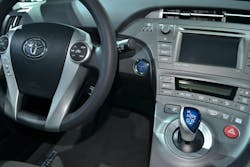Subject: Skills Update: Interior Shutdown Protocols
Topic: Park, parking brake and ignition shutdown procedures
Objective: Adapt and update the task of placing a crash-damaged vehicle into park, setting the parking brake and turning the ignition off.
Task: The rescue team shall study interior components and features of late-model vehicles so that the tasks of placing the vehicle into park, setting the parking brake, and turning off the ignition can be readily accomplished at a real-world incident scene.
The Skills Update series continues our look at common vehicle rescue tasks with a focus on how these tasks have to be changed or modified because of new vehicle designs and technologies. In this article, we address the three interior rescuer tasks: 1) putting a crash-damaged vehicle into park, 2) setting the parking brake and 3) turning off the ignition.
Things have changed significantly within the interior of late-model vehicles. Rescuers used to be assured that they would encounter a gear selector either on the steering column or on the center console. We are used to a mechanical parking brake operated either by their foot or a hand lever as well as a physical key in the ignition. These older style, mechanical controls are fading away as we encounter newer model vehicles at crash scenes with a wide variety of keyless features and electronic controls—the automobile’s version of “fly-by-wire” technology.
Once inside a crash-damaged vehicle, our first goal is to move the transmission from drive to park. With late-model vehicles, rescuers many encounter many new options, such as a joystick shifter, a knob that has to be rotated, or even push buttons to place the vehicle into park.
Once in park, next we set the parking brake. On newer vehicles, this has transitioned from the mechanical foot pedal or hand lever to an electric button or switch. Remember, because these components are electronic, they only function when 12-volt electrical power is still intact. If the battery has been shutdown prior to this step, these electronic switches will not work.
Finally, turning the vehicle’s ignition off has evolved from turning the old, familiar ignition key to pushing an engine stop/start button. These buttons may be found on the instrument panel or along the center console, generally to the right side of the steering column.
It is imperative that first responders keep up with these technological advances to ensure the safety of everyone on scene at a motor vehicle accident.






